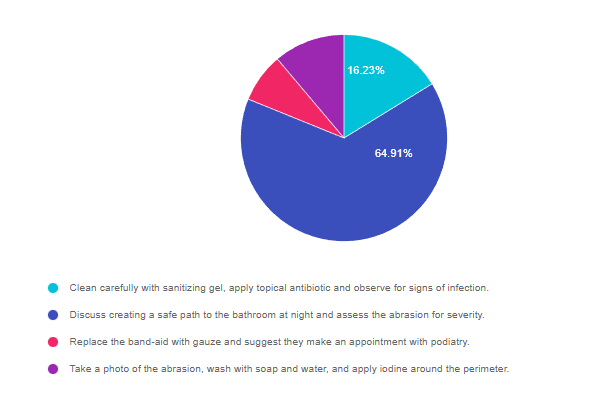
For last week’s practice question, we quizzed test takers on the best treatment for abrasions 65% of respondents chose the best answer. We want to share this important information, so you can pass it on to people living with diabetes and your colleagues, plus prepare for exam success!
Before we start though, if you don’t want any spoilers and haven’t tried the question yet, you can answer it below: Answer Question
Question: JR is 38 years old and takes insulin twice a day. They mention they went to the bathroom at night, lost their balance, and scraped their shin. They put a band-aid on it, but want you to take a look.
What is the best approach to treat the abrasion?
Answer Choices:
- Clean carefully with sanitizing gel, apply topical antibiotic and observe for signs of infection.
- Discuss creating a safe path to the bathroom at night and assess the abrasion for severity.
- Replace the band-aid with gauze and suggest they make an appointment with podiatry.
- Take a photo of the abrasion, wash with soap and water, and apply iodine around the perimeter.

As shown above, the most common choice was option 2, the second most common answer was option 1, then option 4, and finally option 3.
Getting to the Best Answer
Answer 1 is incorrect. 16.23% chose this answer, “Clean carefully with sanitizing gel, apply topical antibiotic and observe for signs of infection.” This is a juicy answer, but not the best answer for this situation for two main reasons. Applying topical antibiotic is a great idea, but generally, abrasions are cleansed with soap and water instead of sanitizing gel. In addition, this answer did not address the core issue, of improving safety when going to the bathroom at night.
Answer 2 is correct. 64.91% of you chose this answer, “Discuss creating a safe path to the bathroom at night and assess the abrasion for severity.” YES, GREAT JOB, this is the best answer. Many lower extremity falls, scrapes and injuries happen on the way to the bathroom when it is dark. It is important to make sure people have a safe path, including night lights and removal of any potential fall risks, especially for older people with balance issues.
Answer 3 is incorrect. 7.71% of respondents chose this answer, “Replace the band-aid with gauze and suggest they make an appointment with podiatry.” It is important to evaluate and treat the abrasion, but it does not warrant an automatic referral to the podiatrist, especially since it is on the shin. Also, this question does not provide enough details about the severity of the wound to determine if further treatment is required.
Finally, Answer 4 is incorrect. 11.16% chose this answer, “Take a photo of the abrasion, wash with soap and water, and apply iodine around the perimeter.” Of course it is a great idea to evaluate an abrasion, but iodine can cause skin irritation and not usually recommended as an antiseptic. In addition, this answer did not address the core issue, of improving safety when going to the bathroom at night.









